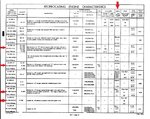Shortround6
Lieutenant General
In some cases fighters went for several years with the same engine. Spitfire was first flown in 1936 and while it didn't fly with a Merlin III the engine used wasn't far off. Production planes went into service in the summer of 1938 with Merlin II engines and the only difference between a II and a III was the prop shaft. Spitfire didn't get a higher powered engine until summer/fall of 1940 with the Merlin XII. Granted better fuel allowed the Merlin III to operate at higher boost for more power but that wasn't really a planned capability.
P-40s are ordered in April of 1939, First production planes are delivered in May of 1940. British order the equivalent of the P-40D about the same time. First P-40D doesn't fly until a year later with the "New" engine.
The First F4U production plane flew in June of 1942, the First F4U fitted with a water injection system on the production line was in Nov 1943, the 1551st Corsair built by Vought. Please note that both Brewster and Goodyear were building Corsairs at this point. There was no better performing R-2800 at this time except the turbo version in the P-47 and that required a LOT more volume inside the fuselage so it wasn't a "drop in" substitute. It wasn't even possible with out major redesign/modification.
Some planes seemed to get a new model engine every few months (exaggeration) like the 109 that went through 4 or more versions of the DB 601 from 1939 to 1942 and in 1942 switched to the DB 605 which went through at least 4 more versions by the spring of 1945. Spitfires after 1940 also seemed to be members of the engine of the month club (joke) with something like 18-19 different Merlins possibly fitted before you even get to the Griffons. Granted some had very small differences between them.
Fighters were usually designed with the best possible engine likely to be available when production was possible (often 1-2 years away, sometimes 3), sometimes engine development was slow or is some cases canceled which forced substitutions. Sometimes for the better and sometimes not.
P-40s are ordered in April of 1939, First production planes are delivered in May of 1940. British order the equivalent of the P-40D about the same time. First P-40D doesn't fly until a year later with the "New" engine.
The First F4U production plane flew in June of 1942, the First F4U fitted with a water injection system on the production line was in Nov 1943, the 1551st Corsair built by Vought. Please note that both Brewster and Goodyear were building Corsairs at this point. There was no better performing R-2800 at this time except the turbo version in the P-47 and that required a LOT more volume inside the fuselage so it wasn't a "drop in" substitute. It wasn't even possible with out major redesign/modification.
Some planes seemed to get a new model engine every few months (exaggeration) like the 109 that went through 4 or more versions of the DB 601 from 1939 to 1942 and in 1942 switched to the DB 605 which went through at least 4 more versions by the spring of 1945. Spitfires after 1940 also seemed to be members of the engine of the month club (joke) with something like 18-19 different Merlins possibly fitted before you even get to the Griffons. Granted some had very small differences between them.
Fighters were usually designed with the best possible engine likely to be available when production was possible (often 1-2 years away, sometimes 3), sometimes engine development was slow or is some cases canceled which forced substitutions. Sometimes for the better and sometimes not.

